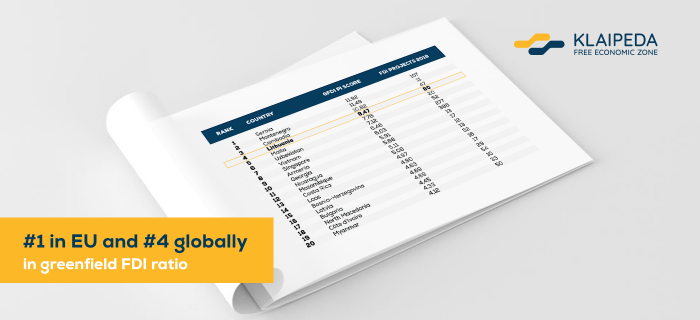News & Events
Watch our activity in one place
Lithuania Retains 4th Place on the Investment Front

Lithuania remains the fourth-best greenfield investment “hunter” in the world, according to the Greenfield FDI Performance Index 2019 report, released by fDi Intelligence, the foreign direct investment monitoring (FDI) and analysis division of The Financial Times.
The leaders in this index were determined by comparing the country’s worldwide economic weight with the share of foreign direct investment the country attracted. The 2019 Index was compiled using data from FDIs throughout 2018, writes Verslo žinios business daily.
The amount of greenfield investment Lithuanian companies attracted to the country was more than eight times greater than the country’s share of the worldwide GDP per capita (8.5 index, with 7.7 recorded in 2017). This score remains the best among the European Union countries.
Achieving the index score of 1 and more means that the amount of greenfield investment from foreign direct sources matches the amount of GDP the country generates on a worldwide scale. An index greater than 1 means that the country attracts more investment than its share of the worldwide GDP. A score that is less than 1 means that the country’s contribution to the worldwide GDP is greater than the amount of foreign direct GI it brings in.
Marius Stasiukaitis, the Regulatory Affairs Expert at Invest Lithuania, comments that it is much more important to complete the marathon than to achieve great results in a sprint.
“It is better to be in the top 10 for 20 years than to place first once and then disappear,” he says.
According to the expert, Lithuania should consider making it to the top 5 two years in a row and to the top 10 three times a success. “The biggest challenge Lithuania faces now is remaining attractive to investors. To meet this goal, we need sweeping changes in our education system because we lack qualified specialists we need to keep our investment numbers growing,” M. Stasiukaitis points out.
Except for Latvia, which doubled the amount of greenfield investment it managed to attract in 2018 to rise by 10 positions, to the 16th place worldwide, Lithuania’s other direct neighboring competitors for greenfield investment seem to be significantly weaker. Poland dropped to the 28th place in the index from the 20th. Estonia rose to the 30th from the 33rd, boosted by big manufacturing investor projects in the renewable energy sector from the Netherlands and the US.
“Latvia recorded big Swedish and Estonian investment projects in electricity generation, manufacturing and building sectors. This is what determined the rise of Latvia in the index,” continues M. Stasiukaitis.
Eimantas Kiudulas, the CEO of the Klaipeda FEZ, is happy to see that Lithuania is keeping its momentum in attracting new greenfield investments but also reminds that it is necessary to work towards creating an ecosystem of high added value.
“The result from the 2019 Index shows that at least some investors are looking for lower-cost countries and regions. It is great to see that we are continuing to develop our R&D and talent-driven sectors, utilize our undeniable geographic and infrastructural advantages. With that said, looking towards the future, the education, support and attraction of a highly qualified workforce and the added value it can create will be the deciding factor in Lithuania’s competitiveness and attractiveness to investors,” says E. Kiudulas.
fDi Intelligence states that there were 80 greenfield investment projects carried out in Lithuania in 2018, while only 61 was recorded in 2017. In 2016, Lithuania was in 9th place, rose by 5 places in 2017 and stopped progressing when it came to evaluating the 2018 results.
2018 is the second year in a row where well-known international companies set up in Lithuania, acting as bait of sorts for other investors as well. 2017 was notable for auto electronics manufacturer Continental and accommodations service provider Booking.com investing in Lithuania. Last year, British banking technology center Barclays reconsidered closing its Lithuanian branch after the US financial services corporation Moody’s decided to set up in Lithuania.
Out of the 10 biggest economies in the world, only the UK (2.6), India (1.5), France (1.3), Canada (1.04) and Germany (1.01) had a Greenfield FDI Performance Index score exceeding 1. Both the US (0.4), Japan and China failed to do it.
This year’s GI index recorded some newcomers, including Montenegro, which catapulted to the 2nd place and North Macedonia (18th), which has finally solved its longstanding naming conflict with Greece, opening a path towards membership in NATO and the EU.
To make it to the Index, a country has to record at least 10 greenfield investments in a year. Greenfield investments are foreign direct investments into a new factory, logistics or other subsidiaries in a foreign country. Reinvestments or acquisitions and mergers between companies operating in different jurisdictions do not count as greenfield investments.
